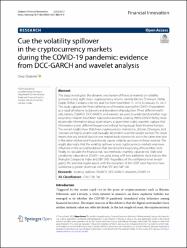Cue the volatility spillover in the cryptocurrency markets during the COVID-19 pandemic: evidence from DCC-GARCH and wavelet analysis
Abstract
This study investigates the dynamic mechanism of fnancial markets on volatility
spillovers across eight major cryptocurrency returns, namely Bitcoin, Ethereum, Stellar,
Ripple, Tether, Cardano, Litecoin, and Eos from November 17, 2019, to January 25, 2021.
The study captures the fnancial behavior of investors during the COVID-19 pandemic
as a result of national lockdowns and slowdown of production. Three diferent methods, namely, EGARCH, DCC-GARCH, and wavelet, are used to understand whether cryptocurrency markets have been exposed to extreme volatility. While GARCH family models provide information about asset returns at given time scales, wavelets capture that
information across diferent frequencies without losing inputs from the time horizon.
The overall results show that three cryptocurrency markets (i.e., Bitcoin, Ethereum, and
Litecoin) are highly volatile and mutually dependent over the sample period. This result
means that any kind of shock in one market leads investors to act in the same direction
in the other market and thus indirectly causes volatility spillovers in those markets. The
results also imply that the volatility spillover across cryptocurrency markets was more
infuential in the second lockdown that started at the beginning of November 2020.
Finally, to calculate the fnancial risk, two methods—namely, value-at-risk (VaR) and
conditional value-at-risk (CVaR)—are used, along with two additional stock indices (the
Shanghai Composite Index and S&P 500). Regardless of the confdence level investigated, the selected crypto assets, with the exception of the USDT were found to have
substantially greater downside risk than SSE and S&P 500.
Volume
8Issue
1Collections
The following license files are associated with this item:


















